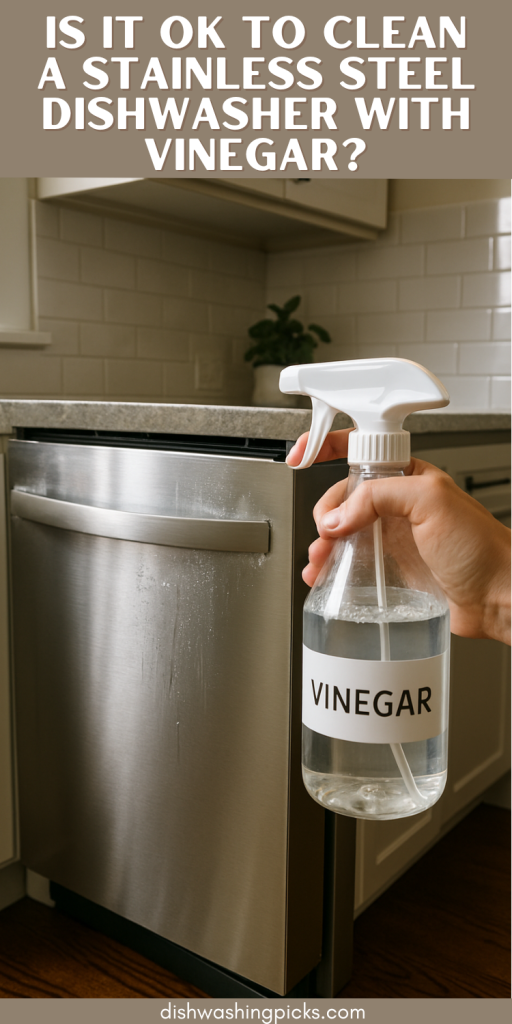
Stainless Steel Isn’t Invincible
Picture this:
Your once-shiny stainless steel dishwasher is starting to look a little… sad. Fingerprints, cloudy streaks, maybe even that mysterious smell that screams “something died behind the rinse cycle.”
And you think:
“Time for a deep clean. Vinegar’s the go-to, right?”
Hold up.
Vinegar does have a rep for being a natural cleaning champ. But when it comes to stainless steel dishwashers, it’s not always a simple yes or no.
The short answer? Yes, you can use vinegar—but you’ve got to do it the smart way to avoid damaging the very surface you’re trying to save.
Let’s break it down.
What Makes Vinegar So Popular for Cleaning?
First off, why vinegar?
Well, it’s:
- Natural
- Non-toxic
- Super cheap
- Great at dissolving mineral buildup, grease, and grime
- Smells… interesting, but does the job
And when it comes to dishwashers, it’s a fan favorite for tackling hard water deposits and lingering smells.
So far, so good, right?
Yes—but here’s the twist: vinegar is still an acid. And stainless steel doesn’t always love prolonged exposure to acid.
Which brings us to…
The Catch: Stainless Steel + Vinegar = Handle With Care
Here’s what you don’t want to do:
Dump a bunch of vinegar on the inside walls
Let it sit there for hours
Soak your stainless steel racks or panels directly
Why?
- Acidic corrosion. Over time, vinegar can actually eat away at the protective layer of stainless steel, especially if it pools in seams or crevices.
- Discoloration. Prolonged contact might dull or tarnish that beautiful finish.
So how do you safely use vinegar to clean your dishwasher? Let’s get to the good stuff.
How to Properly Clean a Stainless Steel Dishwasher with Vinegar
Here’s a safe and effective method to get your dishwasher gleaming again without damaging anything:
Step 1: Empty the Dishwasher
Take out all dishes, racks, and any bits of food hanging around. Start with a clean slate.
Step 2: Inspect the Drain
Check the drain area for gunk—yes, we said it. Old bits of pasta, seeds, or that mystery item from two weeks ago? Get rid of it now.
Step 3: Place a Cup of Vinegar on the Top Rack
Fill a dishwasher-safe cup or bowl with white vinegar and place it upright on the top rack (never pour it directly into the bottom).
Why the top rack? Because:
- It lets the vinegar vaporize and circulate evenly
- It avoids concentrated acid contact with stainless steel surfaces
Step 4: Run a Hot Water Cycle
Use the hottest water setting available. This helps break down grease, limescale, and odors while the vinegar does its thing.
Important: Don’t use detergent during this step—just the vinegar!
Step 5: Optional – Baking Soda Boost
If your dishwasher needs extra deodorizing or brightening, sprinkle a cup of baking soda on the bottom of the tub and run a short hot cycle afterward. This freshens things up without damaging anything.
What About Cleaning the Exterior?
Good question. If your dishwasher has a stainless steel front, don’t just spritz vinegar and walk away.
Instead, use this simple combo:
- A few drops of dish soap mixed with warm water for everyday smudges
- A dab of vinegar on a microfiber cloth for tough spots (wipe it off quickly!)
Pro tip: Always wipe with the grain of the stainless steel for a polished, streak-free shine.
So… Is Vinegar Safe or Not?
Let’s recap:
| Scenario | Vinegar Safe? | Notes |
| Vinegar in a cup on top rack | ✅ Yes | Best method—no direct contact with stainless steel |
| Spraying vinegar directly inside | ⚠️ Risky | Can corrode or discolor over time |
| Cleaning stainless exterior | ✅ Yes (carefully) | Wipe off quickly, don’t let it sit |
| Soaking stainless parts in vinegar | ❌ Nope | May cause corrosion or pitting |
So yes—vinegar is your friend when used with a bit of strategy. It’s not a pour-and-pray solution, but it is effective when done right.
Keep It Clean, Keep It Safe
Your dishwasher works hard. Giving it a good clean with vinegar can help it run better, smell fresher, and last longer.
But like any good cleaning routine, it’s all about balance.
Use vinegar the right way, keep your stainless shining, and avoid turning a quick clean into a costly mistake. Deal?
